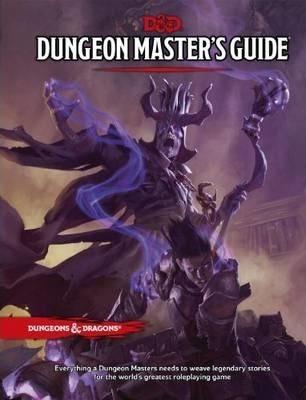Dungeon Master's Guide (D&D Core Rulebook)

Weave legendary stories in the world's greatest roleplaying game. All you need to run a Dungeons & Dragons game is your imagination, some dice, and this book. The Dungeon Master's Guide teaches you how to how to run D&D adventures for your players-- how to invent monsters for them to fight, mysteries for them to solve, and fantasy worlds for them to explore. "[The Dungeon Master's Guide is] the one book to rule them all, the most comprehensive and powerful set of resources needed to run a game of D&D. . ."
--Charlie Hall, Polygon.com "D&D acolytes are everywhere...Tech workers from Silicon Valley to Brooklyn have long-running campaigns, and the showrunners and the novelist behind 'Game of Thrones' have all been Dungeon Masters."--Neima Jahromi, The New Yorker - The Dungeon Master's Guide is one of the three main Dungeons & Dragons books, along with the Player's Handbook and Monster Manual. It's a reference used by the Dungeon Master (the game's narrator) to create adventures--to run Dungeons & Dragons games and fill them with characters and stories. - The Dungeon Master's Guide (DMG) is full of tools to help you immerse players in the game. What's the demon lord's secret weakness? Are the orcish invaders a criminal enterprise, or traitorous allies? Dozens of tables throughout the book help inspire your decisions and keep the game flowing smoothly. - In the Dungeon Master's Guide (DMG), even the tables tell tales. A legendary sword takes five decades to craft. Who created it, and why? A tavern-crawling gnome has an eye twitch. How did she get it, and when? In every detail is an architecture for narrative--and the Dungeon Master's Guide has all the tools you need to flesh it out with ease. - In Dungeons & Dragons, you and your friends coauthor your own legend. Guided by a Dungeon Master, you create characters and play their roles in a story, rolling dice and navigating maps as you unfold a tale as limitless as your imagination. - Dungeons & Dragons is the world's greatest roleplaying game. Created in 1974, D&D transformed gaming culture by blending traditional fantasy with miniatures and wargaming.
--Charlie Hall, Polygon.com "D&D acolytes are everywhere...Tech workers from Silicon Valley to Brooklyn have long-running campaigns, and the showrunners and the novelist behind 'Game of Thrones' have all been Dungeon Masters."--Neima Jahromi, The New Yorker - The Dungeon Master's Guide is one of the three main Dungeons & Dragons books, along with the Player's Handbook and Monster Manual. It's a reference used by the Dungeon Master (the game's narrator) to create adventures--to run Dungeons & Dragons games and fill them with characters and stories. - The Dungeon Master's Guide (DMG) is full of tools to help you immerse players in the game. What's the demon lord's secret weakness? Are the orcish invaders a criminal enterprise, or traitorous allies? Dozens of tables throughout the book help inspire your decisions and keep the game flowing smoothly. - In the Dungeon Master's Guide (DMG), even the tables tell tales. A legendary sword takes five decades to craft. Who created it, and why? A tavern-crawling gnome has an eye twitch. How did she get it, and when? In every detail is an architecture for narrative--and the Dungeon Master's Guide has all the tools you need to flesh it out with ease. - In Dungeons & Dragons, you and your friends coauthor your own legend. Guided by a Dungeon Master, you create characters and play their roles in a story, rolling dice and navigating maps as you unfold a tale as limitless as your imagination. - Dungeons & Dragons is the world's greatest roleplaying game. Created in 1974, D&D transformed gaming culture by blending traditional fantasy with miniatures and wargaming.



 '
' '
' '
' '
' '
'